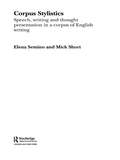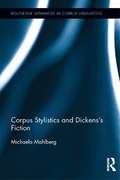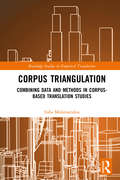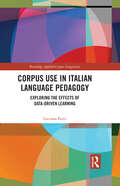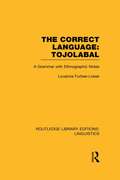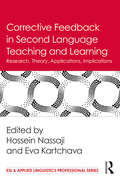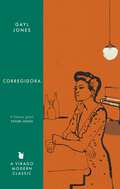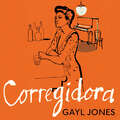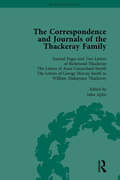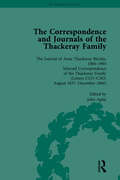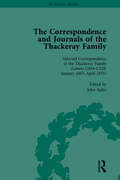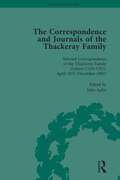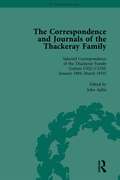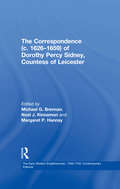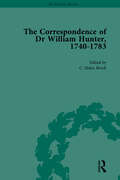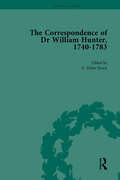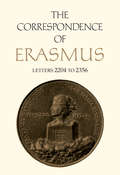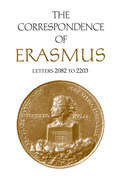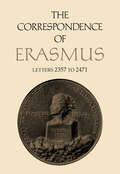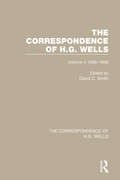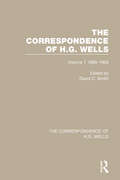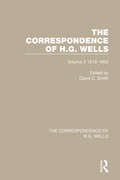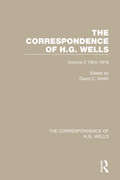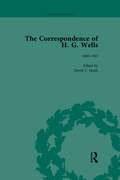- Table View
- List View
Corpus Stylistics: Speech, Writing and Thought Presentation in a Corpus of English Writing (Routledge Advances in Corpus Linguistics #Vol. 5)
by Elena Semino Mick ShortThis book combines stylistic analysis with corpus linguistics to present an innovative account of the phenomenon of speech, writing and thought presentation - commonly referred to as 'speech reporting' or 'discourse presentation'.This new account is based on an extensive analysis of a quarter-of-a-million word electronic collection of written narrative texts, including both fiction and non-fiction. The book includes detailed discussions of: The construction of this corpus of late twentieth-century written British narratives taken from fiction, newspaper news reports and (auto)biographies The development of a manual annotation system for speech, writing and thought presentation and its application to the corpus. The findings of a quantitive and qualitative analysis of the forms and functions of speech, writing and thought presentation in the three genres represented in the corpus. The findings of the analysis of a range of specific phenomena, including hypothetical speech, writing and thought presentation, embedded speech, writing and thought presentation and ambiguities in speech, writing and thought presentation. Two case studies concentrating on specific texts from the corpus. Corpus Stylistics shows how stylistics, and text/discourse analysis more generally, can benefit from the use of a corpus methodology and the authors' innovative approach results in a more reliable and comprehensive categorisation of the forms of speech, writing and thought presentation than have been suggested so far. This book is essential reading for linguists interested in the areas of stylistics and corpus linguistics.
Corpus Stylistics and Dickens's Fiction (Routledge Advances in Corpus Linguistics #14)
by Michaela MahlbergThis book presents an innovative approach to the language of one of the most popular English authors. It illustrates how corpus linguistic methods can be employed to study electronic versions of texts by Charles Dickens. With particular focus on Dickens’s novels, the book proposes a way into the Dickensian world that starts from linguistic patterns. The analysis begins with clusters, i.e. repeated sequences of words, as pointers to local textual functions. Combining quantitative findings with qualitative analyses, the book takes a fresh view on Dickens’s techniques of characterisation, the literary presentation of body language and speech in fiction. The approach brings together corpus linguistics, literary stylistics and Dickens criticism. It thus contributes to bridging the gap between linguistic and literary studies and will be a useful resource for both researchers and students of English language and literature.
Corpus Triangulation: Combining Data and Methods in Corpus-Based Translation Studies (Routledge Studies in Empirical Translation and Multilingual Communication)
by Sofia MalamatidouDespite the recognition that corpus-based translation research would benefit from the triangulation of corpora, little has been done in the direction of actually employing combined corpus data and methods in the field. This book aims to address this gap by providing a much needed detailed account of corpus triangulation, where different corpora (e.g. parallel, comparable, synchronic, diachronic) and/or different methods of analysis (e.g. qualitative, quantitative) can be used to increase our understanding of the phenomena where translation plays a key role. The book also demonstrates clearly how the proposed methodology can be fruitfully employed to investigate different linguistic features, through its systematic application to empirical data. The first part of the book introduces the innovative framework for corpus triangulation, which is based on a new and comprehensive corpus typology, while the second part applies the methodological framework to two case studies examining the language of translation and the relationship between translation and language change. The book advances current translation studies in terms of methodology innovation and offers a model on which future studies investigating the network of relationships surrounding translated texts can be based.
Corpus Use in Italian Language Pedagogy: Exploring the Effects of Data-Driven Learning (Routledge Applied Corpus Linguistics)
by Luciana FortiCorpus Use in Italian Language Pedagogy: Exploring the Effects of Data-Driven Learning provides a comprehensive overview of corpus use in Italian L2 Pedagogy. The author addresses Italian language corpus resources, their potential uses in pedagogical settings, and the range of research methods available to evaluate their effectiveness. Overall, the book: provides a comprehensive account of Italian corpora and corpus-based research on Italian that can inform the design, implementation and evaluation of DDL practices in Italian learning and teaching contexts traces the history of DDL, by describing its origins and discussing its theoretical underpinnings, in relation to both linguistics and pedagogy examines the state-of-the-art in DDL research, in light of the available empirical evidence on both etic and emic dimensions, while placing particular emphasis on the methodological gaps illustrates the main methodological challenges in researching DDL, from corpus resource selection to empirical evaluation of its pedagogical effectiveness, and describes how they can be overcome demonstrates, by means of an in-depth case study, how the guidelines provided above can be applied when researching DDL effects in a specific second language learning and teaching context discusses the overall challenges the field faces today, while outlining some desirable avenues for future research and pedagogical practice This book will not only be of interest to those conducting research in corpus linguistics and teaching in the Italian domain, but also to those working with other languages.
The Correct Language, Tojolabal (Routledge Library Editions: Linguistics)
by Louanna Furbee-LoseeDefinitions of language cluster around two non-contradictory views: one that language is a shared code, a social entity, and the other that language is the knowledge that enables a native speaker to produce and understand speech. In examining the language and culture of the Tojolabal (Mayan) Indians of Mexico, this book argues that language is a cognitive system, as is culture, of which language is but a part. The author is most interested in the interfaces between language and social phenomena and between language and other systems of culture, and demonstrates that research on the dialectic between language and social context, and that between language and other systems of culture, leads to fruitful generalizations about the nature of language as a human capacity.
Correcting the Scholarly Record for Research Integrity: In the Aftermath of Plagiarism (Research Ethics Forum #6)
by M. V. DoughertyThis volume is the first book-length study on post-publication responses to academic plagiarism in humanities disciplines. It demonstrates that the correction of the scholarly literature for plagiarism is not a task for editors and publishers alone; each member of the research community has an indispensable role in maintaining the integrity of the published literature in the aftermath of plagiarism. If untreated, academic plagiarism damages the integrity of the scholarly record, corrupts the surrounding academic enterprise, and creates inefficiencies across all levels of knowledge production. By providing case studies from the field of philosophy and related disciplines, the volume exhibits that current post-publication responses to academic plagiarism are insufficient. It catalogues how humanities disciplines fall short in comparison with the natural and biomedical sciences for ensuring the integrity of the body of published research. This volume provides clarity about how to conceptualize the scholarly record, surveys the traditional methods for correcting it, and argues for new interventions to improve the reliability of the body of published research. The book is valuable not only to those in the field of philosophy and other humanities disciplines, but also to those interested in research ethics, meta-science, and the sociology of research.
Corrective Feedback in Second Language Teaching and Learning: Research, Theory, Applications, Implications (ESL & Applied Linguistics Professional Series #66)
by Hossein Nassaji Eva KartchavaBringing together current research, analysis, and discussion of the role of corrective feedback in second language teaching and learning, this volume bridges the gap between research and pedagogy by identifying principles of effective feedback strategies and how to use them successfully in classroom instruction. By synthesizing recent works on a range of related themes and topics in this area and integrating them into a single volume, it provides a valuable resource for researchers, graduate students, teachers, and teacher educators in various contexts who seek to enhance their skills and to further their understanding in this key area of second language education.
Corregidora (Virago Modern Classics #785)
by Gayl Jones'No novel about any black woman could ever be the same after this' TONI MORRISON'Corregidora is the most brutally honest and painful revelation of what has occurred, and is occurring, in the souls of Black men and women' JAMES BALDWINUpon publication in 1975, Corregidora was hailed as a masterpiece, winning acclaim from writers including James Baldwin, Maya Angelou, Toni Morrison and John Updike. Exploring themes such as race, sexuality and the long repercussions of slavery, this powerful novel paved the way for Beloved and The Colour Purple. Now, this lost classic is published for a new generation of readers.Blues singer Ursa is consumed by her hatred of Corregidora, the nineteenth-century slave master who fathered both her mother and grandmother. Charged with 'making generations' to bear witness to the abuse embodied in the family name, Ursa Corregidora finds herself unable to keep alive this legacy when she is made sterile in a violent fight with her husband. Haunted by the ghosts of a Brazilian plantation, pained by a present of lovelessness and despair, Ursa slowly and firmly strikes her own terms with womanhood.AS HEARD ON THE BACKLISTED PODCAST'A literary giant, and one of my absolute favourite writers' TAYARI JONES, author of AN AMERICAN MARRIAGEAlso new to the VMC list: Eva's Man and The Healing by Gayl Jones.'An American writer with a powerful sense of vital inheritance, of history in the blood' JOHN UPDIKE'Gayl Jones's first novel, Corregidora (1975), was both shocking and ground-breaking in its probing of the psychological legacy of slavery and sexual ownership through the life of a Kentucky blues singer ... it predated Alice Walker's The Color Purple and Toni Morrison's Beloved, revealing an unfinished emancipation and the power of historical memory to shape lives. It also marked a shift in African-American literature that made women, and relationships between black people, central' MAYA JAGGI, Guardian'Corregidora's survey of trauma and overcoming has become even better and more relevant with the passage of time. It remains an indispensable point of entry into the tradition of African American writing that Gayl Jones reshaped and enriched' PAUL GILROY
Corregidora (Virago Modern Classics #785)
by Gayl Jones'No novel about any black woman could ever be the same after this' TONI MORRISON'Corregidora is the most brutally honest and painful revelation of what has occurred, and is occurring, in the souls of Black men and women' JAMES BALDWINUpon publication in 1975, Corregidora was hailed as a masterpiece, winning acclaim from writers including James Baldwin, Maya Angelou, Toni Morrison and John Updike. Exploring themes such as race, sexuality and the long repercussions of slavery, this powerful novel paved the way for Beloved and The Colour Purple. Now, this lost classic is published for a new generation of readers.Blues singer Ursa is consumed by her hatred of Corregidora, the nineteenth-century slave master who fathered both her mother and grandmother. Charged with 'making generations' to bear witness to the abuse embodied in the family name, Ursa Corregidora finds herself unable to keep alive this legacy when she is made sterile in a violent fight with her husband. Haunted by the ghosts of a Brazilian plantation, pained by a present of lovelessness and despair, Ursa slowly and firmly strikes her own terms with womanhood.AS HEARD ON THE BACKLISTED PODCAST'A literary giant, and one of my absolute favourite writers' TAYARI JONES, author of AN AMERICAN MARRIAGEAlso new to the VMC list: Eva's Man and The Healing by Gayl Jones.'An American writer with a powerful sense of vital inheritance, of history in the blood' JOHN UPDIKE'Gayl Jones's first novel, Corregidora (1975), was both shocking and ground-breaking in its probing of the psychological legacy of slavery and sexual ownership through the life of a Kentucky blues singer ... it predated Alice Walker's The Color Purple and Toni Morrison's Beloved, revealing an unfinished emancipation and the power of historical memory to shape lives. It also marked a shift in African-American literature that made women, and relationships between black people, central' MAYA JAGGI, Guardian'Corregidora's survey of trauma and overcoming has become even better and more relevant with the passage of time. It remains an indispensable point of entry into the tradition of African American writing that Gayl Jones reshaped and enriched' PAUL GILROY
The Correspondence and Journals of the Thackeray Family Vol 1
by John AplinMarking the bicentenary of the birth of William Makepeace Thackeray in 1811, this five-volume set presents a collection of materials relating to the novelist and to his gifted family.
The Correspondence and Journals of the Thackeray Family Vol 2
by John AplinMarking the bicentenary of the birth of William Makepeace Thackeray in 1811, this five-volume set presents a collection of materials relating to the novelist and to his gifted family.
The Correspondence and Journals of the Thackeray Family Vol 3
by John AplinMarking the bicentenary of the birth of William Makepeace Thackeray in 1811, this five-volume set presents a collection of materials relating to the novelist and to his gifted family.
The Correspondence and Journals of the Thackeray Family Vol 4
by John AplinMarking the bicentenary of the birth of William Makepeace Thackeray in 1811, this five-volume set presents a collection of materials relating to the novelist and to his gifted family.
The Correspondence and Journals of the Thackeray Family Vol 5
by John AplinMarking the bicentenary of the birth of William Makepeace Thackeray in 1811, this five-volume set presents a collection of materials relating to the novelist and to his gifted family.
The Correspondence: The Correspondence (1588-1621) Of Robert Sidney, First Earl Of Leicester, And Barbara Gamage Sidney, Countess Of Leicester (The Early Modern Englishwoman, 1500-1750: Contemporary Editions)
by Michael G. Brennan Noel J. KinnamonThe letters of Dorothy Percy Sidney, Countess of Leicester, dating predominantly from about 1636 until 1643, cover a wide range of issues and vividly illustrate her centrality to her illustrious family's personal and public affairs. These c.100 letters are here for the first time fully transcribed and edited. The edition includes a biographical and historical introduction, setting the context of the Sidneys' family and political activities at the time of Dorothy's marriage to Robert in 1615 and then tracing the major events and involvements of her life until her death in 1659. A key to the cipher used in the letters to disguise identities of individuals is also supplied. Following the introduction is the complete text of each of Dorothy Percy Sidney's letters to her husband, Robert, second Earl of Leicester, and to and from William Hawkins, the Sidney family solicitor, along with several others, including letters from Dorothy to Archbishop Laud and the Earl of Holland. Her husband's account of her last moments in 1659, and testamentary directions relating to her will, are also included. The letters are arranged in chronological order and supported by a series of footnotes that elucidate their historical context and briefly to identify key individuals, places, political issues and personal concerns. These notes are further supported by selective quotations from Dorothy's incoming correspondence and other related letters and documents. A glossary supplies more detailed information on 'Persons and Places.' Dorothy Percy Sidney's letters eloquently convey how, even with her undoubted personal potency and shrewd intelligence, the multifaceted roles expected of an able and determined aristocratic early modern Englishwoman-especially when her husband was occupied abroad on official business-were intensely demanding and testing.
The Correspondence of Dr William Hunter Vol 1
by Helen BrockBorn in Scotland, Dr William Hunter (1718-83) pursued an extensive medical education in Glasgow, Edinburgh, London and Paris. He settled in London where he made his name as an anatomist and obstetrician before being elected to the Royal Society in 1767. This book presents all of his known correspondence, drawing upon archives around the world.
The Correspondence of Dr William Hunter Vol 2
by Helen BrockBorn in Scotland, Dr William Hunter (1718-83) pursued an extensive medical education in Glasgow, Edinburgh, London and Paris. He settled in London where he made his name as an anatomist and obstetrician before being elected to the Royal Society in 1767. This book presents all of his known correspondence, drawing upon archives around the world.
The Correspondence of Erasmus
by Alexander Dalzell James M. Estes Desiderius ErasmusThe letters in this volume reflect Erasmus' anxiety about the endemic warfare in Western Europe, the advance of the Ottoman Turks into Europe, and the increasing threat of armed conflict between Catholics and Protestants in Germany. Unable and unwilling to attend the Diet of Augsburg (June-November 1530), summoned by Emperor Charles V in the attempt to mediate a religious settlement, Erasmus corresponded with those in attendance, urging them (in vain) to preserve peace at all costs.The letters also shed light on Erasmus' controversies with Catholic critics (Luis de Carvajal and Frans Titelmans) who accused him of Lutheran sympathies, and former friends among the Protestant reformers (Gerard Geldenhouwer and others in Strasbourg), who embarrassed him by citing him in support of their views. Because of a mysterious and debilitating illness (identified in an appendix to the volume) the twelve months covered were less productive of scholarship than was usual for Erasmus, but it did see the publication of the five-volume Froben edition of St. John Chrysostom in Latin.
The Correspondence of Erasmus: Letters 2082 to 2203
by Desiderius Erasmus James M. Estes Alexander DalzellThis volume contains the surviving correspondence of Erasmus for the first seven months of 1529. For nearly eight years he had lived happily and productively in Basel. In the winter of 1528-9, however, the Swiss version of the Lutheran Reformation triumphed in the city, destroying the liberal-reformist atmosphere Erasmus had found so congenial. Unwilling to live in a place where Catholic doctrine and practice were officially proscribed, Erasmus resettled in the quiet, reliably Catholic university town of Freiburg im Breisgau, Despite the turmoil of moving, Erasmus managed to complete the new Froben editions of Seneca and St Augustine, both monumental projects that had been underway for years. He also found time to engage in controversy with his conservative Catholic critics, as well as to write a long letter lamenting the execution for heresy of his friend Louis de Berquin at Paris. Volume 15 of the Collected Works of Erasmus series.
The Correspondence of Erasmus: Letters 2357 to 2471
by James M. Estes Desiderius Erasmus Charles FantazziMany of the letters in this volume, which covers the period August 1530 to March 1531, reflect Erasmus' anxieties over events at the Diet of Augsburg (June-November 1530), at which the first of many attempts to achieve a negotiated settlement of the religious division in Germany came to a rancorous conclusion, thus fostering the fear that religious controversy would eventually lead to war. His other chief concerns were the continued attacks on him by Catholic critics who regarded him as a clandestine Lutheran, and the insistence of many evangelical reformers that he was their spiritual father. The literary output of the period covered includes major works aimed at members of both groups.
The Correspondence of H.G. Wells: Volume 4 1935–1946 (The Correspondence of H.G. Wells #4)
by David C. SmithThis collection of H.G. Wells's correspondence draws on over 50 archives and libraries worldwide, including the papers of Wells's daughter by Amber Reeves. The book contains over 2,000 letters, and while a few are business – to publishers, agents and secretaries – the majority are much more personal. Wells's private correspondence extends from letters to President Franklin Roosevelt and Prime Ministers Winston Churchill and A.J. Balfour, to persons such as ‘Mark Benney’, who wrote novels based on his life in the slums and his time in prison. There is correspondence too with his many female friends and lovers, among them Rebecca West, Eileen Power, Gertrude Stein, Marie Stopes, Lilah MacCarthy and Dorothy Richardson. For example, a letter from Moura Budberg, with whom Wells had a long-standing affair, which announces that she is pregnant by him and about to have an abortion, reveals how an advocate of birth control is himself caught out. Wells also enjoyed correspondence with the press, particularly during the two World Wars, and with various BBC officials and people who worked on his films. Some of his letters on the controversies of free love, socialism, birth control, the Fabian Society, and the nature of the curriculum of the new London University in the 1890s are included. Interspersed chronologically with Wells's letters is a small selection of about 40 letters to Wells, where letters from him are not extant. Among these are letters from Ray Lankester, Joseph Conrad, C.G. Jung, Trotsky, Hedy Gatternigg (the woman who attempted suicide in Wells's flat), and J.C. Smuts. The letters are arranged in these periods: Volume 1 1878–1900; Volume 2 1901–1912; Volume 3 1913–1930; and Volume 4 1930–1946. H.G. Wells's works include The Time Machine (1895), The Invisible Man (1897), The War of the Worlds (1898), The History of Mr Polly (1910), and A Short History of the World (1922).
The Correspondence of H.G. Wells: Volume 1 1880–1903 (The Correspondence of H.G. Wells #1)
by David C. SmithThis collection of H.G. Wells's correspondence draws on over 50 archives and libraries worldwide, including the papers of Wells's daughter by Amber Reeves. The book contains over 2,000 letters, and while a few are business – to publishers, agents and secretaries – the majority are much more personal. Wells's private correspondence extends from letters to President Franklin Roosevelt and Prime Ministers Winston Churchill and A.J. Balfour, to persons such as ‘Mark Benney’, who wrote novels based on his life in the slums and his time in prison. There is correspondence too with his many female friends and lovers, among them Rebecca West, Eileen Power, Gertrude Stein, Marie Stopes, Lilah MacCarthy and Dorothy Richardson. For example, a letter from Moura Budberg, with whom Wells had a long-standing affair, which announces that she is pregnant by him and about to have an abortion, reveals how an advocate of birth control is himself caught out. Wells also enjoyed correspondence with the press, particularly during the two World Wars, and with various BBC officials and people who worked on his films. Some of his letters on the controversies of free love, socialism, birth control, the Fabian Society, and the nature of the curriculum of the new London University in the 1890s are included. Interspersed chronologically with Wells's letters is a small selection of about 40 letters to Wells, where letters from him are not extant. Among these are letters from Ray Lankester, Joseph Conrad, C.G. Jung, Trotsky, Hedy Gatternigg (the woman who attempted suicide in Wells's flat), and J.C. Smuts. The letters are arranged in these periods: Volume 1 1878–1900; Volume 2 1901–1912; Volume 3 1913–1930; and Volume 4 1930–1946. H.G. Wells's works include The Time Machine (1895), The Invisible Man (1897), The War of the Worlds (1898), The History of Mr Polly (1910), and A Short History of the World (1922).
The Correspondence of H.G. Wells: Volume 3 1919–1934 (The Correspondence of H.G. Wells #3)
by David C. SmithThis collection of H.G. Wells's correspondence draws on over 50 archives and libraries worldwide, including the papers of Wells's daughter by Amber Reeves. The book contains over 2,000 letters, and while a few are business – to publishers, agents and secretaries – the majority are much more personal. Wells's private correspondence extends from letters to President Franklin Roosevelt and Prime Ministers Winston Churchill and A.J. Balfour, to persons such as ‘Mark Benney’, who wrote novels based on his life in the slums and his time in prison. There is correspondence too with his many female friends and lovers, among them Rebecca West, Eileen Power, Gertrude Stein, Marie Stopes, Lilah MacCarthy and Dorothy Richardson. For example, a letter from Moura Budberg, with whom Wells had a long-standing affair, which announces that she is pregnant by him and about to have an abortion, reveals how an advocate of birth control is himself caught out. Wells also enjoyed correspondence with the press, particularly during the two World Wars, and with various BBC officials and people who worked on his films. Some of his letters on the controversies of free love, socialism, birth control, the Fabian Society, and the nature of the curriculum of the new London University in the 1890s are included. Interspersed chronologically with Wells's letters is a small selection of about 40 letters to Wells, where letters from him are not extant. Among these are letters from Ray Lankester, Joseph Conrad, C.G. Jung, Trotsky, Hedy Gatternigg (the woman who attempted suicide in Wells's flat), and J.C. Smuts. The letters are arranged in these periods: Volume 1 1878–1900; Volume 2 1901–1912; Volume 3 1913–1930; and Volume 4 1930–1946. H.G. Wells's works include The Time Machine (1895), The Invisible Man (1897), The War of the Worlds (1898), The History of Mr Polly (1910), and A Short History of the World (1922).
The Correspondence of H.G. Wells: Volume 2 1904–1918 (The Correspondence of H.G. Wells #2)
by David C. SmithThis collection of H.G. Wells's correspondence draws on over 50 archives and libraries worldwide, including the papers of Wells's daughter by Amber Reeves. The book contains over 2,000 letters, and while a few are business – to publishers, agents and secretaries – the majority are much more personal. Wells's private correspondence extends from letters to President Franklin Roosevelt and Prime Ministers Winston Churchill and A.J. Balfour, to persons such as ‘Mark Benney’, who wrote novels based on his life in the slums and his time in prison. There is correspondence too with his many female friends and lovers, among them Rebecca West, Eileen Power, Gertrude Stein, Marie Stopes, Lilah MacCarthy and Dorothy Richardson. For example, a letter from Moura Budberg, with whom Wells had a long-standing affair, which announces that she is pregnant by him and about to have an abortion, reveals how an advocate of birth control is himself caught out. Wells also enjoyed correspondence with the press, particularly during the two World Wars, and with various BBC officials and people who worked on his films. Some of his letters on the controversies of free love, socialism, birth control, the Fabian Society, and the nature of the curriculum of the new London University in the 1890s are included. Interspersed chronologically with Wells's letters is a small selection of about 40 letters to Wells, where letters from him are not extant. Among these are letters from Ray Lankester, Joseph Conrad, C.G. Jung, Trotsky, Hedy Gatternigg (the woman who attempted suicide in Wells's flat), and J.C. Smuts. The letters are arranged in these periods: Volume 1 1878–1900; Volume 2 1901–1912; Volume 3 1913–1930; and Volume 4 1930–1946. H.G. Wells's works include The Time Machine (1895), The Invisible Man (1897), The War of the Worlds (1898), The History of Mr Polly (1910), and A Short History of the World (1922).
The Correspondence of H G Wells Vol 1
by H G Wells David Smith Patrick ParrinderThis collection of H.G. Wells's correspondence draws on over 50 archives and libraries worldwide, including the papers of Wells's daughter by Amber Reeves. The book contains over 2000 letters, both business and personal. Wells's private correspondence includes letters to Winston Churchill.
